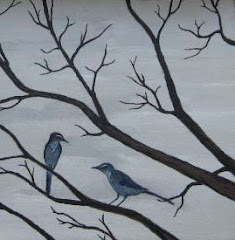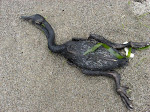The loose flocks of yellow-rumped warblers, such as the myrtle subspecies male below, remain in the neighborhood flitting from one small tree to another.
 This week, they have been joined by another bright bird, the western tanager. I usually see tanagers high in tall conifers, so it is great to find them in little trees that are still leafing out. No binoculars required.
This week, they have been joined by another bright bird, the western tanager. I usually see tanagers high in tall conifers, so it is great to find them in little trees that are still leafing out. No binoculars required.Also newly arrived are flocks of barn swallows. They build their open-toped mud nests in the buildings that surround small parks or open areas in our the neighborhood. Last year, several nests were built in an awning near a Walgreens. Today, a pair was staking out a nesting territory on the same awning. Toward the end of the summer, this is the only species still nesting in the area. Barn swallows are highly productive birds with large clutch sizes, multiple nesting attempts, and high nest survival. Juvenile and adult survival must be low, otherwise, they would be blackening the skies.
Sarah and I are preparing for our upcoming Birdathon trip entitled “The Murre, the Merrier” We will be leading a group to the Oregon coast to see as many birds and raise as much money for Portland Audubon as possible. We expect a large species count because many wintering, migrating, and nesting species are now in the area. We are busy listening to tapes of migratory bird song to refresh our memories from previous years. We also keep a hopeful eye on the weather forecasts and reports of interesting birds. We led our first Birdathon trip last year and had a great time, so we are looking forward to this year’s excursion. I will post results next week.

























































